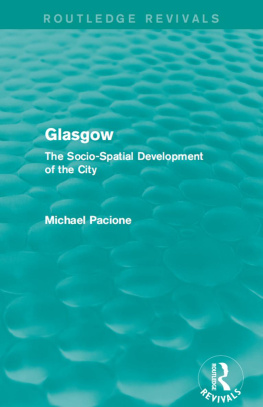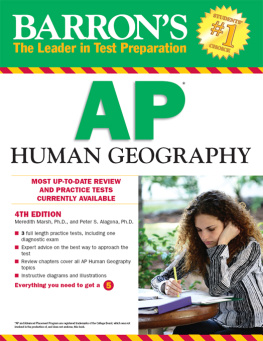Routledge Revivals
Progress in Agricultural Geography
In the second half of the twentieth century, significant changes were occurring within the agricultural industry, including an increase in efficiency and government intervention, as well as expanded and more complicated patterns of trade. This comprehensive volume, first published in 1986, reflects how these developments challenged the field of agricultural geography. Considering agricultural innovations, farming systems, government policy and land ownership, this title provides an essential background to students with an interest in agricultural methods, distribution and reform.
First published in 1986
by Croom Helm Ltd
This edition first published in 2013 by Routledge
2 Park Square, Milton Park, Abingdon, Oxon, OX14 4RN
Simultaneously published in the USA and Canada
by Routledge
711 Third Avenue, New York, NY 10017
Routledge is an imprint of the Taylor & Francis Group, an informa business
1986 Michael Pacione
All rights reserved. No part of this book may be reprinted or reproduced or utilised in any form or by any electronic, mechanical, or other means, now known or hereafter invented, including photocopying and recording, or in any information storage or retrieval system, without permission in writing from the publishers.
Publishers Note
The publisher has gone to great lengths to ensure the quality of this reprint but points out that some imperfections in the original copies may be apparent.
Disclaimer
The publisher has made every effort to trace copyright holders and welcomes correspondence from those they have been unable to contact.
A Library of Congress record exists under LC control number: 85031389
ISBN 13: 978-0-415-70748-0 (hbk)
ISBN 13: 978-1-315-88673-2 (ebk)
1986 Michael Pacione
Croom Helm Ltd, Provident House, Burrell Row,
Beckenham, Kent BR3 1AT
Croom Helm Australia Pty Ltd, Suite 4, 6th Floor,
6476 Kippax Street, Surry Hills, NSW 2010, Australia
British Library Cataloguing in Publication Data
Progress in agricultural geography
1. Agricultural geography
I. Pacione, Michael
338.109 S439
ISBN 0-7099-2095-4
Croom Helm, 51 Washington Street, Dover, New Hampshire, 03820 USA
Library of Congress Cataloging in Publication Data
Main entry under title:
Progress in agricultural geography.
(Croom Helm progress in geography series)
Includes index.
Contents: theory and methodology in agricultural
geography / B.W. Ilberyclassification of
agricultural systems / J.W. Aitchisondiffusion of
agricultural innovations / G. Clark(etc.)
1. Agricultural geographyaddresses, essays,
lectures. I. Pacione, Michael. II. Series.
S494.5.G46P76 1986 630.9 85-31389
ISBN 0-7099-2095-4
Filmset by Mayhew Typesetting, Bristol, England
Printed and bound in Great Britain
by Billing & Sons Limited, Worcester.
CONTENTS
To Christine, Michael John and Emma Victoria
Agriculture can be defined as management of the land for purposes of producing plant and animal products to satisfy human needs. It is both a way of life and an economic activity. Traditionally, the geographical study of agriculture was regarded as a sub-branch of cultural geography or economic geography, with strong links to cognate subject areas in economics and sociology. More recently, agricultural geography has emerged as a multi-faceted field of inquiry in its own right.
Study of the structure and pattern of agricultural activity has long formed a focus for researchers interested in agricultural typology, productivity evaluation, innovation diffusion and location theory and modelling. The techniques employed in the analysis of these topics have generally evolved with the subject to ensure that such themes continue to represent foci for investigation. Since the early 1970s, however, these traditional concerns have been augmented by new issues including the industrialisation of farming and its impact upon rural economic and social structures, land use change and conflict with particular attention devoted to the loss of good quality agricultural land to urban development, the institutional determinants of agricultural activity, part-time farming and multiple job-holding, agricultural marketing and distribution, land owner-ship and the agricultural land market, and the world food problem.
This collection of original essays is designed to encapsulate the major themes and recent developments in a number of areas of central importance in agricultural geography. The volume is a response to the need for a text which reviews the progress and current state of the subject and which provides a reference point for future developments in agricultural geography.
Michael Pacione,
University of Strathclyde,
Glasgow.
Just as the history of Mankind is closely related to the history of agriculture, so agricultural geography has long been a key component of human geography. In and various strategies to analyse farmers goals and values, including repertory grid procedures and point score analysis. In spatial terms a particular focus of attention is the dynamic farming environment of the rural-urban fringe. Each of these major theoretical perspectives has formed a focal point for research in agricultural geography during the post-war era. No single viewpoint in isolation is sufficient to explain contemporary agricultural patterns. What is required is an integrated approach which recognises the contribution each can make to understanding the complexity of the agricultural landscape.
Classification is a fundamental component of scientific enquiry and within agricultural geography the classification and regionalisation of farming systems represents a long-established objective. In IGU classification of European agriculture, are considered to be more appropriate than classification methods for comparative investigations and for studies of temporal change. The principal advantage of the latter suite of algorithms (e.g. principal component analysis with or without a contiguity constraint) is their suitability for multivariate information sets and the fact that the resulting typology or regionalisation emerges from the data (i.e. is determined by the characteristics of the taxonomic units) and is not imposed. An illustration of how the two procedures can be combined is provided by a study of farming regions in France. In conclusion, it is suggested that insufficient consideration has been given to the question of the quality of particular typologies or regionalisation. It is recommended that this deficiency be offset by more rigorous examination of the effects of methodological differences on taxonomic results. In the final analysis, however, the utility of any classification is determined by how well it satisfies the objectives of the investigation.
The adoption of new techniques is an essential part of the agricultural development process. In are examined. The way in which this relationship can lead to regional and individual inequalities is also demonstrated. In order to gain insight into the complexity and, in some instances, apparent economic irrationality of decision-making it is necessary to complement generalised macro-scale studies and theoretical formulations with investigation of the impact of innovations on the social and economic position of individuals. Finally, three key areas of future research are identified: (1) fuller consideration of the processes which influence the kinds of innovation made available to potential adopters, (2) study of the reciprocal effects which operate between innovations and the structure of economies and societies, and (3) further investigation of how decisions on the transmission and adoption of innovations are taken by organisations and individuals.



